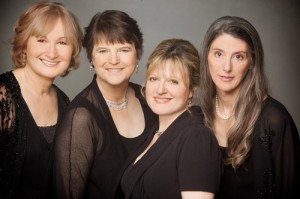Fuse Concert Review: A Lively Anonymous 4
The Anonymous 4 went through their medieval and early Renaissance paces, vibrato-less but historically informed and performed.
By Susan Miron
Last Sunday’s concert featuring the Anonymous 4 afforded me my first look at the new Isabella Stewart Gardner Museum wing and its much-discussed, brand-new Calderwood Hall, home to its prestigious Sunday Concert Series.
A celebrated quartet of women celebrating their 25th year as an ensemble, Anonymous 4 has made 18 recordings of medieval, contemporary, and American music. Much of the afternoon felt like a promo for their many successful recordings. (In the first paragraph of their bio, it says their listeners have bought nearly two million copies of the group’s albums on the Harmonia Mundi label).
The first page of their program divided their themes into Ladymass, Legends, Visions and Miracles, Sisterhood, Ardor, and Partings with the pieces next to the albums on which they could be found. Everything was there except for the names of the group’s members. How to distinguish them in a review? The one with heels? The one with really long hair? Beaded jacket? Whoever they are, they have a resumé any group would envy. There was no mystery about their recordings: after each piece in the program, there was a mention of the CD the piece was from and when it was made. (In all fairness, this makes it easier for people to know what to buy).
The 75-minute program that followed was a mixed affair. I was sitting to the group’s left on the first floor where presumably the best acoustics are. After attending so many early music concerts replete with charismatic speakers who introduced their group and their music, this concert was oddly silent –just four women in black standing there singing.
Their program notes were good, but with little to watch, I found myself looking at the seating above me, at the people who were peering down. A good dozen elbows rested on the glass partitions. I felt I was in a recording studio; there was a disconnect between me and the singers. The strangeness of sitting in a cube with three layers of cubes above me was very unsettling. Perhaps on other concerts I’ll get used to it, but yesterday I desperately missed the old Tapestry Room where the Sunday concerts used to take place and where I had played so many times. This felt too 21st century for my tastes.
The four went through their medieval and early Renaissance paces, vibrato-less but historically informed and performed. Many offerings concerned Christmas, and I kept thinking how much better this music would sound and feel in a dimly lit church on Christmas Eve. I also kept musing that their brief, written introductions would be more audience-friendly if read by one of the group members. Of course, this would have added a few minutes on to their goal of a 75-minute concert, but it would have kept them from seeming so, well, anonymous.
One of the best pieces on the program “the wood and the vine” (composed by David Lang, 2011) is part of a larger work in progress called “love fail.” The composer writes he aimed “to make this song seem like a description of a relationship of a man and a woman, in an era, gone hopelessly wrong. The man in my version . . . tells the woman that they ‘are like the vine that winds itself around the branch . . . If someone pulls the two apart then both will die. So he writes a song about it, and he calls it the wood and the vine’ So I named my piece that too.” One, two, or three at a time the women would sing again and again “the wood and the vine” around the tale itself, so the refrain felt very much like a vine. It was hypnotic and quite beautiful.
The ballad-carol that came next was also lovely, although I would have liked to hear it in a church.”The Christmas Tree” (2101) juxtaposes English carols with American tunes descended from British ancestors. The notes explain that the story of the infant Jesus’s prophetic and miraculous conversation with his mother recurs often in old (the text is Middle English, I believe) British poetry and song.
There was a new version of The Lord’s Prayer by John Tavener, a piece from the Mass for the Ascention written in 1000. Medieval Hungarian Christmas music, an Irish hymn sung wonderfully by the only singer who wore heels. The seriously famous Hildegard of Bingen was represented on the program by “11,000 Virgins” about the early Christian martyr Ursula who was killed at Cologne with a host of 11,000 virgin handmaidens. The antiphon was very calm and calming despite its gruesome imagery. It certainly made me want to hear more from this composer. There were more songs of love to the Virgin Mary, and finally some secular music.
An half-anonymous singer identified as Marsha was completely at home in the folk song “You fair and pretty ladies” about a girl who risked all for love, and lost. Marsha has been singing this song for a really long time, and as far as I am concerned, she can have a career in folk music any time she wants one. Another folk hymn, “Parting Friends” ended the program. My test for loving a group is if I end up buying their CDs. I might get Gloryland to hear “You fair and pretty ladies” again, but for now I think I’ll stick to their recordings on You Tube.



